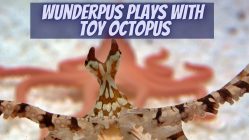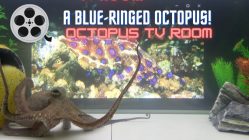
In the most fantastical ideas dealing with octopuses, none are grander in the figurative and literal sense than those involving huge octopuses. Be it in literature, in movies or in legends passed down through the centuries by seafarers, stories of giant octopuses are a common thread.
“The Kraken” is the best example of these myths. While giant octopuses capable of wrapping their arms around entire ships and dragging them under with all hands on board are the realm of pure fantasy, giant octopuses on their own are not.
Giant Pacific Octopus Facts
- Scientific Name : Enteroctopus Dofleini
- Common Name: Giant Pacific Octopus
- Size: 3m – 6m (8-16 ft) average
- Weight: 40 – 80kg (80 – 160 pounds) average
- Lifespan: average 5 years
- Found in: North Pacific
- Sub-Order: Incirrina
- Discovered: 1910
- Scientific Name : Enteroctopus Dofleini
- Common Name: Giant Pacific Octopus
- Size: 3m – 6m (8-16 ft) average
- Weight: 40 – 80kg (80 – 160 pounds) average
- Lifespan: average 5 years
- Found in: North Pacific
- Sub-Order: Incirrina
- Discovered: 1910
If the word “Giant” appears in your name, chances are that you are going to be large. That is exactly the case with the Giant Pacific Octopus. It is the largest of all of the 300-plus species of octopuses alive today.
What? Giant Octopuses Do Exist?

Yes, giant octopuses do exist. They may not be as large as some of the myths and legends make them out to be, but they do exist. It is highly probable that these real giant octopuses were the inspiration for the legends that we have already mentioned.
We are talking about a species of octopus commonly known as the Giant Pacific Octopus. If you are curious about how big these creatures can get, where they live and how they live — then keep on reading. In the process, you will learn some of the most interesting facts about this splendidly impressive creature.
—Size of the Giant Pacific Octopus—

If the word “Giant” appears in your name, chances are that you are going to be large. That is exactly the case with the Giant Pacific Octopus. It is the largest of all of the 300-plus species of octopuses alive today.
The scientific name for this species is Enteroctopus dofleini. Try saying that a few times in a row and you will understand why we will refer to this octopus by its common name throughout this article.
A specimen of the Giant Pacific octopus was once discovered which measured just over 30 feet in length and weighed in at 600 pounds. This particular specimen was washed ashore on the coast of British Columbia in Canada. As of mid-2019, it still represents the largest octopus specimen of any species to have been cataloged scientifically.
The consensus opinion among marine biologists is that larger specimens of this species likely exist. A full length of 45 to 50 feet is often cited as the expected upper limits in size for the Giant Pacific Octopus.
When talking about the outlying limits of size for any creature it is important to also mention the average size for the species. The average Giant Pacific Octopus measures 8 to 16 feet in length and weighs 80 to 160 pounds.
Be it in the wild or in a marine life aquarium, you will be more likely to see a Giant Pacific octopus in the 14 to 16-foot range than one measuring longer than that.
—Habitat and Range of the Giant Pacific Octopus—

The Giant Pacific Octopus is found in a large swath of the — wait for it — Pacific Ocean.
It lives in an area that covers the coasts of Northern California, Oregon, Washington, Western Canada, eastern Russia and Siberia, Japan, and Korea. Yeah, that’s one large chunk of the ocean that is preferred by this large cephalopod.
Not only is this species of octopus found in such a wide spatial area but it is also found in a wide range of individual habitats. The Giant Pacific Octopus can be found making its home in very deep water. We are talking about depths of water that surpass 6,000 feet. It can also be found in the shallow water associated with intertidal zones near the coast.
Could There Be Multiple Species?
It had been postulated that the reason for such a wide disbursement in terms of range and individual habitat for the Giant Pacific Octopus was because it was, in fact, more than one species. More recent DNA analysis of different specimens from different habitats indicates that they are all one species divided into three sub-species.
These three sub-species of the Giant Pacific octopus reside in Puget Sound, off the coast of Alaska, and in the area of Japan and Korea respectively.
—Lifespan—
Most octopus species have short lifespans. The majority only live for one or two years — a few even less. The Giant Pacific Octopus is not only the largest octopus but it is also one of the longest-lived. In the wild, they can live to an age of five years. For octopuses that’s considered ancient.
—Reproduction Cycle—

All octopuses are semelparous. This means that they only mate once in their lifetime. This takes place toward the end of their natural lifespan.
To be more exact, the act of mating is what ushers in biological changes in both the males and females of the species which culminate in death soon afterward.
Octopuses lack genitals. In other words, they do not have the private parts that we mammals have. The male Giant Pacific octopus takes a sperm packet containing his sperm and using one of his arms inserts it in the mantle of the female’s head.
Yes, it may seem like an odd way to mate but for the Giant Pacific Octopus, it works. Some females carry around this sperm packet for months inside their head until they are ready to fertilize their eggs.
Each female can produce as many as 400,000 eggs. The average number of eggs laid by the Giant Pacific octopus is 200,000.
With such numbers, you’d think that the Pacific Ocean would be choked with Giant Pacific Octopuses. The reality, of course, is different. Only a small percentage of Giant Pacific Octopus hatchlings make it to adulthood. Most fall prey to other sea creatures while they are still small.
—Growth and Life Cycle of the Giant Pacific Octopus—

Giant Pacific octopus eggs are very tiny for such a large creature. They are smaller than a grain of rice. When they hatch, the hatchlings are no bigger than this.
The incubation cycle for the Giant Pacific octopus eggs is six months. During that time the mother octopus dedicates every moment of the day to their care. She will keep them clean removing accumulations of algae. She will constantly circulate water around them with her arms to keep them well oxygenated. Of course, she will also protect them from predators. In terms of motherhood, mother octopuses are very devoted.
For the six months that she spends incubating and caring for her eggs, she does not eat. Her body begins a process of self-consumption that results in systemic failure of major body systems soon after the eggs hatch. It can be said that she starves herself for the benefit of the next generation of octopuses.
The male Giant Pacific octopus faces a different, although equally as fatal fate after mating. The act of mating changes the behavior of the males. They begin to spend more time in open water exposing themselves to predators. It is as if a death wish takes over after mating on the part of the males.
For the hatchlings that do survive, they grow at a rate of nearly one percent per day. They are very efficient at converting food energy into body mass.
—Diet—

As all octopus species, the Giant Pacific octopus is a hunter. They hunt and eat a variety of crustaceans and mollusks. Crabs, shrimp, scallops, lobsters, sea snails — they all make up the diet of the Giant Pacific octopus.
These octopuses have also been observed to catch and eat dogfish sharks as large as five feet in length. They also enjoy the occasional fish as part of their diet.
There is even photographic evidence of a Giant Pacific octopus capturing a seagull above the water and hauling it in for a meal.
—Hunting Style and Movement of the Giant Pacific Octopus—

This species of octopus is known to reach speeds of 25 MPH when engaged in short swimming sprints through the water. These speeds are usually reserved to escape danger or to close the gap on fleeing prey. They achieve such speed by funneling water to create mini jet streams.
While capable of such speeds, the Giant Pacific octopus relies more frequently on stealth and cunning when it comes to hunting. They are able to alter the color and pattern of their skin to blend in with their surroundings. This not only protects them from predators but it also allows them to lay in wait for prey to approach. Sort of like you waiting for the pizza delivery guy to show up at your door.
Each arm of the Giant Pacific Octopus is lined with suckers. Individually, each sucker can hold as much as 35 pounds each. This means that when an animal crosses the path of the Giant Pacific octopus few are going to be able to escape its clutches.
It is not uncommon for these octopuses to use the web of skin that connects each of their arms as a sort of canopy “trap”. They can literally enclose a prey in a blanket of death.
When it needs to move about on the ocean floor to reposition itself, it relies on its arms as legs and can walk or crawl along the bottom.
—The Hunter Is Also the Hunted—

As formidable of a hunter as the Giant Pacific octopus is, in spite of its uncanny intelligence, it is also prey for other sea creatures.
When they are still small they can fall victim to large baleen whales as they scoop up zooplankton from the water.
As they grow larger, toothed-whales, such as sperm whales, hunt the Giant Pacific octopus as an important part of their diet. So do seals and otters when it comes to octopuses that stay closer to shore in shallower water.
Pacific sleeper sharks are also known to hunt this large octopus.
The Giant Pacific octopus is also hunted by humans for food. While not one of the top species popular for consumption, it is known as a delicacy in certain Asian cuisine.
—Oxygen Requirements—

Having a large body mass, it is obvious that the Giant Pacific octopus is going to have a high demand for oxygen. One of the reasons that it prefers to keep brisk movements to a minimum is precisely to minimize the need for massive and sudden requirements of oxygen.
The Giant Pacific octopus uses gills to extract oxygen from the water. They can also use their skin as a secondary system for obtaining oxygen from the water that surrounds them.
The blood of the Giant Pacific octopus is copper-based. That means that it relies on hemocyanin to transfer and diffuse oxygen through its system. Unlike hemoglobin, which you have in your blood, hemocyanin is not as efficient at carrying oxygen.
This is also a reason why this octopus prefers water with cooler temperatures. The colder the water, the more oxygen-rich it is.
Why Then Live in Shallower Water?

It might seem like the ideal habitat for an octopus as large as the giant Pacific octopus and its oxygen demands would be to remain in the deepest waters possible. However, this octopus can be found in water as deep as 6,000 feet but, ironically, also in much shallower habitats.
This is because deep water sometimes experiences “oxygen dead zones.” This is a natural occurrence that happens when large quantities (as in tons) of algae and plankton die and settle in massive amounts in a very short period of time on the ocean floor. Their decaying remains consumes the oxygen from the water and makes it no longer suitable for a Giant Pacific octopus.
This is why some migrate to shallower water, not because it is ideal, but because it is better than staying in the deep where they would die of hypoxia. Some return to deeper water when its oxygen levels are replenished. Others remain to partake of available food supplies in the shallower depths. It is believed this is how the sub-species of Giant Pacific octopus in and around Puget Sound arrived and stayed.
—Yes, there Are Giants in the water—
While there are no real Krakens in the oceans there definitely are giants. Blue Whales take the crown for marine mammals. The great white shark for fish, and the Giant Pacific octopus for octopuses.
The Giant Pacific octopus is a testament to the diversity of octopuses in general. Their existence demonstrates how their body shape, hunting style, and skill set provides a winning combination regardless of size. For one species to cover such a wide area of the ocean it means that their adaptiveness does not come from long-term natural selection alone. It also requires on-the-spot intuitiveness and intelligence. Obviously, the Giant Pacific octopus is one big eight-armed smart cookie.











